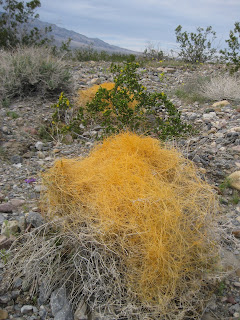



Given its dryness and extreme heat only the hardiest of plants and animals flourish in Death Valley. The two animals we pictures are almost legendary for their survival skills. Apparently, wild burros are not seen often in the Park. Their primary range is southwest of Death Valley. Coyotes, of course, are everywhere. One of the big problems in Death Valley is that tourists want to feed them, which actually threatens their survival.
There are big horn sheep in the Park, but we did not see any. The most talked about animals in the Park is the sidewinder. We did not see one in spite of miles of hiking. We did catch sight of a kangaroo rat, but couldn't get a picture.
One of the other truly unique species in Death Valley are the pupfish. There are actually about ten species of pupfish--all of them on the endangered list. These fish survive in very saline water, are tiny, and are being studied in their native environment in the Park.
It would not surprise you that in an environment this extreme, there is no vegetation or very sparse vegetation over vast areas. The plants that do exist have adapted to the extremes of heat and drouth.
The orange-colored, stringy-looking plant you see in the photo is Dodder. It is a parasitic plant. It lives entirely off other plants and has no roots into the ground at all. It frequently kills its host plant. You can see the host plant beneath the Dodder in the photo.
The fragile flower is called the Gravel Ghost. It is amazingly beautiful and fragile considering the environment in which it lives.
Many of these plants bloom only for a brief period in the early spring if there is adequate rain.
No comments:
Post a Comment